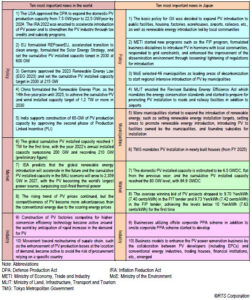The tumultuous year 2022, which the energy situation drastically changed due to the Russia’s invasion of Ukraine, has ended. It was a year for the world to fully focus on the countermeasures against the tight energy supply and demand and the soaring energy prices. Until now, expansion of renewable energy introduction was promoted as a countermeasure to climate change aiming to create a decarbonized society, but under these circumstances, renewable energy was increasingly appraised as a major power source adaptable to energy security, and 2022 became a year in which the policy of expanding renewable energy introduction was enhanced. As shown in Table 1, a great progress was also made to accelerate of introduction of PV power generation.
The USA invoked the Defense Production Act (DPA) and enacted the Inflation Reduction Act (IRA), while EU formulated REPowerEU and Solar Energy Strategy, and resulted in strengthening the PV industry and accelerating the expansion of the global PV introduction. China formulated the Renewable Energy Plan as the 14th five-year plan to realize the combined PV and wind installed capacity target of 1.2 TW or more in 2030. India is supporting the construction of 65-GW PV production capacity through Production Linked Incentive (PLI).
The global annual PV installed capacity significantly increased to 210 GW (preliminary figure) in 2022 from 175 GW in 2021. The annual PV installed capacities by country were China 90 GW, the USA 18.6 GW, India 17 GW, Brazil 12 GW, and Germany 7 GW, and the number of countries with annual installed capacity exceeding 10 GW increased to four. Cumulative PV installed capacity surpassed 1 TW, and is expected to continue to steadily grow toward 2 TW. In 2020, IEA positioned PV as the King of power sources that are to be newly established in the 2020s, prospected a continuous prompt expansion of PV introduction in 2022, and expected that PV will become the world’s largest power source by overtaking coal in 2027.
In Japan, the Sixth Strategic Energy Plan and the Plan for Global Warming Countermeasures were put into action in 2022. The GX (Green Transformation) Implementation Council, chaired by Prime Minister Fumio Kishida, decided on the basic policy aimed at implementing the green transformation . Maximum utilization of renewable energy and nuclear power was clearly stated with the aim to break away from fossil energy. As for renewable energy, definite achievement of the renewable energy ratio of 36 – 38% in the energy mix in FY 2030 is targeted. Promoting the expanded PV introduction to public facilities, housing, factories, warehouses, airports, railways, etc., as an immediate countermeasure, and a policy to introduce renewable energy led by local communities were shown.
The Ministry of Economy, Trade and Industry (METI) started new programs and systems, such as the FIP program, approval cancellation system, and disposal cost reserve system, compiled business disciplines to renewable energy introduction in harmony with local communities, responded to grid constraints and output curtailment such as application of non-firm connections and reviewing grid usage rules, reformed the regulation over installation/ construction, promoted the revision of the Act on the Improvement of Energy Consumption Performance of Buildings (Building Energy Efficiency Act), and strengthened the dissemination environment.
The Ministry of the Environment (MoE) selected 46 municipalities as leading areas of decarbonization to strengthen supports for introduction of self-consumption PV systems by private companies and started a regional intensive PV introduction projects led by municipalities.
The Ministry of Land, Infrastructure, Transport and Tourism (MLIT) enacted the Revised Building Energy Efficiency Act, which mandates housing to comply with energy conservation standards, and is promoting the expansion of PV introduction to facilities of public infrastructure including not only airports but also roads and railways. As for municipalities, many municipalities started efforts to expand the introduction of renewable energy, such as setting renewable energy installation targets, setting areas to promote renewable energy introduction, introducing PV to facilities owned by the municipalities, and founding subsidies for installation.
Tokyo Metropolitan Government (TMG) passed an ordinance to mandate PV Installation in newly built houses starting from FY 2025. Besides Tokyo, Kawasaki City, Kanagawa Prefecture also aims to make PV installation mandatory.
In spite of PV installations supported by the MoE’s subsidy and the FIT/FIP programs, aside from start of operation of the approved capacity under the former FIT program, the domestic PV installed capacity in 2022 is estimated to be 6.5 GWDC, which is in the same level as 2021. While the adoption of the PPA scheme expanded the market for buildings, including housing, factories, and warehouses, the Japanese PV market is assumed to be in the transitional period for creating new installation projects, due to the delay in responding to the new scheme and the soaring price of PV systems.
The PV industry entered a new dissemination environment and is transforming to develop projects utilizing onsite and offsite corporate PPA scheme-based business models. New types of PV introduction projects that integrates power consumers by the collaboration between PV developers (including EPCs) using the former FIT program and conventional energy industries, trading houses, financial institutions, etc., are also emerging. As the number of projects that have not started operation under the former FIT program continues to decrease, the PV industry is seeking ways to develop toward market expansion. However, against the background of the rising electricity bills and penetration of the PPA scheme in the market, the momentum for PV introduction is increasing. In 2023, let the public and private sectors draw a picture of the developing PV industry that leads decarbonization and turn the year to a strong year to reactivate the market toward introduction of 120 GW PV capacity in 2030.
Table 1 Ten most important news related to PV power generation in 2022

